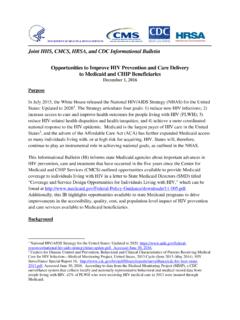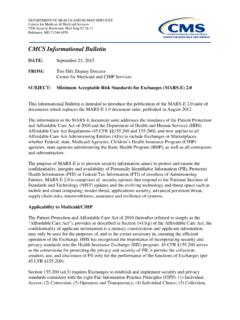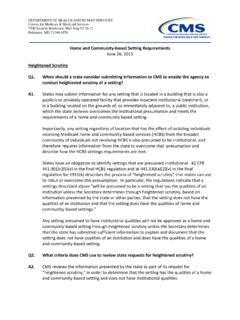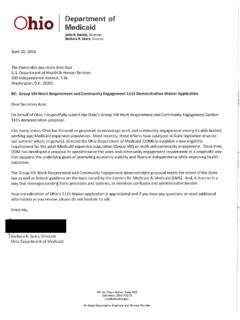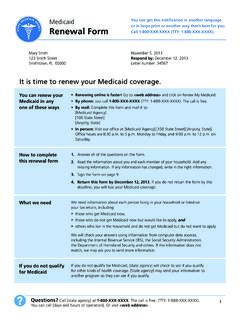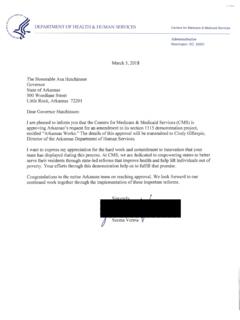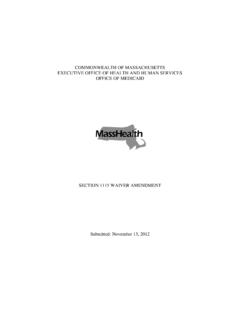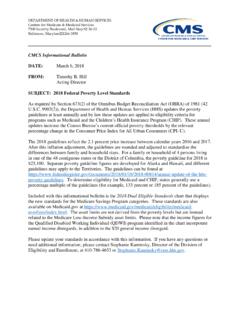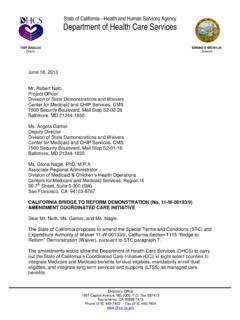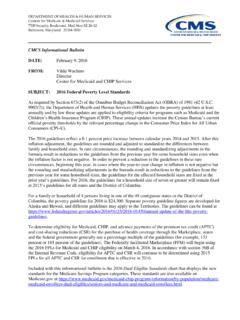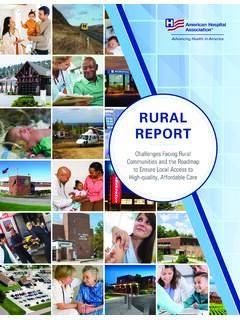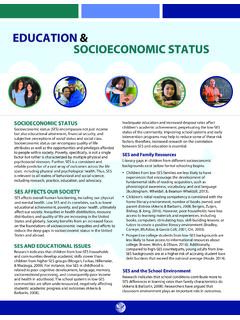Transcription of CMCS Informational Bulletin
1 DEPARTMENT OF health & HUMAN SERVICES Centers for Medicare & Medicaid Services 7500 Security Boulevard, Mail Stop S2-26-12 Baltimore, Maryland 21244-1850 CMCS Informational Bulletin DATE: December 10, 2021 FROM: Daniel Tsai, Deputy Administrator and Director Center for Medicaid & CHIP Services SUBJECT: 2022 Updates to the Child and Adult Core health care quality Measurement Sets This Center for Medicaid & CHIP Services (CMCS) Informational Bulletin describes the 2022 updates to the Core Set of children s health care quality measures for Medicaid and the Children s health Insurance Program (CHIP) (the Child Core Set) and the Core Set of health care quality measures for adults enrolled in Medicaid (the Adult Core Set).
2 A Tool to Advance health quality , Equity, and Access The Core Sets are a foundational tool for understanding the quality of healthcare provided in Medicaid and CHIP. The Core Sets help CMS and states assess the access to and quality of health care being provided to Medicaid and CHIP beneficiaries and identify and improve understanding of the health disparities experienced by Medicaid and CHIP beneficiaries. CMS encourages states to use Core Set data to identify disparities in care and to develop targeted quality improvement efforts to advance health equity. Additionally, the Medicaid and CHIP (MAC) Scorecard uses Core Set data for the majority of the State health System Performance Background Core Set Reporting Progress CMCS released the initial Child Core Set in 2010 and the initial Adult Core Set in 2012.
3 (See ). Currently, by statute, state reporting on these measure sets is ,3 Since the inception of the Child and Adult Core Sets, CMCS has collaborated with state Medicaid and CHIP agencies to voluntarily collect, report, and use the core set measures to drive quality improvement. CMCS worked with stakeholders to identify the two initial measure sets and continues to work with stakeholders to update the Core Sets annually. 4 Over the years, states have made significant progress in reporting. All states, the District of Columbia (DC), and Puerto Rico voluntarily reported at least one Child Core Set measure for 1 2 3 4 Core Set History Table: CMCS Informational Bulletin Page 2 Federal Fiscal Year (FFY) 2020, with 48 states reporting at least half (12) of the measures.
4 States reported a median of 19 Child Core Set measures for FFY 2020. Twenty states reported more Child Core Set measures for FFY 2020 than for FFY 2019. FFY 2020 Child Core Set reporting included the use of alternate data sources to calculate the measure Live Births Weighing Less Than 2,500 Grams (LBW-CH) using CDC data for states that either did not report this measure or who chose to have CMS report it on their behalf. CMS also reported state-level performance on the National Core Indicators Survey (NCIDDS-AD) submitted to the NCI National Team providing self-reported outcomes for individuals with intellectual and developmental disabilities.
5 In addition, T-MSIS data was used to report the Percentage of Eligibles Who Received Preventive Dental Services (PDENT-CH) measure for 18 states. Beginning in FFY 2021, CMS will report both the Live Births Weighing Less Than 2,500 Grams (LBW-CH) and Low-Risk Cesarean Delivery (LRCD-CH) measures on behalf of all states, using CDC data. The number of states reporting Adult Core Set measures has increased steadily from 30 states for FFY 2013 to 50 states for FFY The median number of Adult Core Set measures reported by states is 22 measures for FFY 2020, a slight decrease from measures reported for FFY 2019. Forty-three states reported at least half (16) of the Adult Core Set measures for FFY 2020.
6 In addition, 23 states reported more Adult Core Set measures for FFY 2020 than for FFY 2019. Annual Requirement to Update Core Sets Part of implementing an effective quality measures reporting program is to periodically reassess the measures that comprise it, since many factors, such as changes in clinical guidelines, experiences with reporting, and performance rates may warrant modifying the measure set. Section 1139A of the Social Security Act (the Act), as amended by section 401(a) of the Children s health Insurance Reauthorization Act (CHIPRA) of 2009, provides that, beginning annually in January 2013, the Secretary shall publish recommended changes to the core Section 1139B of the Act, as amended by section 2701 of the Affordable care Act, provides that the Secretary shall issue updates to the Adult Core Set beginning in January 2014 and annually For the 2022 updates to the Child and Adult Core Sets, CMCS contracted with Mathematica, Inc.
7 To convene the 2022 Child and Adult Core Set Annual Review Stakeholder Workgroup (Workgroup) to identify ways to improve the Core The Workgroup included 29 members representing a diverse set of stakeholders, including state Medicaid and CHIP agency representatives, health care providers, health plans, patient advocates, and federal partners who review measures for potential use in other federal public reporting. CMCS also obtained additional input from state Medicaid agencies through the quality Technical Advisory Group, internal Center for Medicare & Medicaid Services (CMS) stakeholder meetings, and interagency federal partners to ensure that the Core Set measures are evidence-based, health equity focused, and promote measure alignment within CMS and across the federal 5 The term states includes the 50 states, the District of Columbia, and Puerto Rico.
8 6 7 CMS Annual Review and Selection Process: CMCS Informational Bulletin Page 3 Additional information about the Child and Adult Core Set Annual Review process and the recommendations to CMCS can be found at: Based on the input received through this Annual Review process, CMCS will be making the following updates to the 2022 Core Sets. 2022 Child Core Set Updates CMCS will retire two measures: Audiological Diagnosis No Later than 3 Months of Age (AUD-CH) National quality Forum (NQF) #1360 due to State-reported challenges in CMS recognizes the importance of this health care area and will assess options to address this gap.
9 Percentage of Eligibles Who Received Preventive Dental Services (PDENT-CH) because it does not focus on evidence-based interventions to prevent tooth decay as it captures information on services that go beyond the two evidence-based preventive dental services for children, which are fluoride and CMS recognizes the importance of oral health to overall health and will replace this measure with two measures: Oral Evaluation, Dental Services and Topical Fluoride for Children (described below). CMCS will add four new measures: Oral Evaluation, Dental Services (OEV-CH).10 This measure determines the percentage of enrolled children younger than age 21 who received a comprehensive or periodic oral evaluation within the reporting year.
10 Topical Fluoride for Children (TFL-CH).10 This measure assesses the percentage of children ages 1 through 20 years who received at least 2 topical fluoride applications as (a) dental or oral health services, (b) dental services, and (c) oral health services within the reporting Follow-Up After Emergency Department Visit for Alcohol and Other Drug Abuse or Dependence: Ages 13-17 (FUA-CH).12 This measure assesses the percentage of emergency department (ED) visits for beneficiaries age 13 and older with a principal diagnosis of alcohol or other drug (AOD) abuse or dependence who had a follow-up visit for AOD abuse or dependence.
